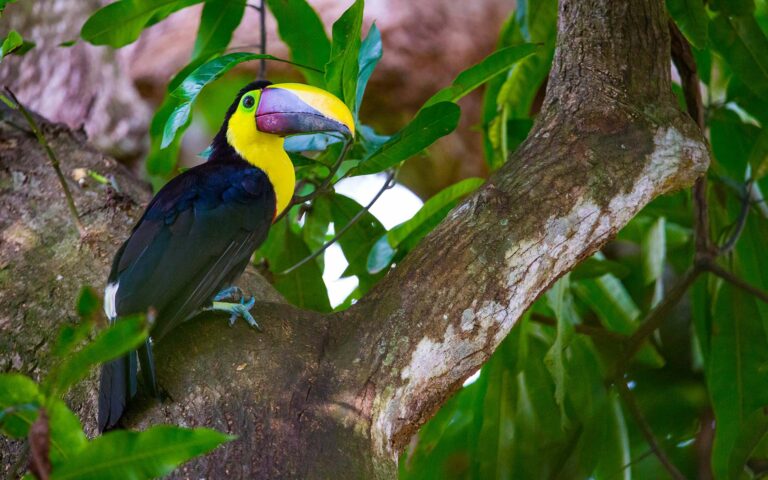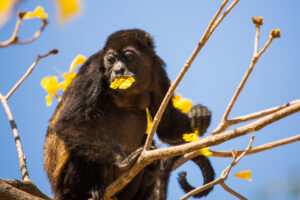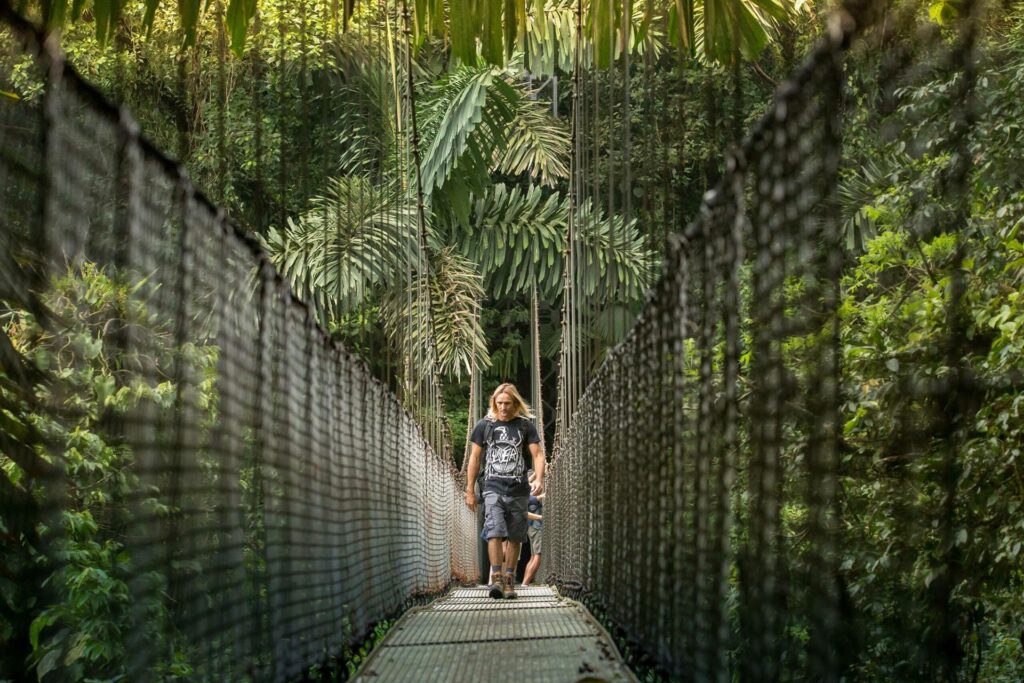The canopy: a world in balance between Earth and sky. A tropical and vegetal link between the tops of trees and the undergrowth. Accessible to humans for just 50 years, this floral paradise is the most lively in the world, a very summit of biodiversity. Powered by the sun’s rays, it brings together various mammals, multicolored birds, twirling butterflies and reptiles. Nourished by the overabundance of fruits and leaves, they contribute to this ecosystem. Let’s understand in a few lines the intelligence of life. How does the canopy in Costa Rica fight against global warming? What fauna and flora live there? And no, the suspended bridges of Monteverde do not have the monopoly of the visit.
Canopy in Costa Rica – An intelligent ecosystem
The etymology of the word canopy refers to the notions of cover and sail. Upper floor of the rainforest, the only point of contact with the atmosphere. It is only in the last 50 years that men have had the technical means to access it to study it. Scientists estimate that it hosts 70-90% of the forest’s life. Animals find refuge and food there. It is from their interaction with floral species that this immense richness is born.
Beneficial cooling effect against global warming
Canopy, like an umbrella of the forest up to 40 meters. Consisting of branches and leaves, the upper layer serves as a cover for the rest of the flora. If the canopy receives 100% of the sun’s rays, it filters them down to 0.5% on the ground. Why? Because it:
- protects the roots of plants and small trees from UV and heat;
- regulates moisture by capturing 30% of precipitation;
- allows the growth of cover plants for the undergrowth.
The cooling effect of the crown of trees allows a better adaptation of the flora to global warming. Studies conducted by a European consortium, consisting of the Federal Institute for Forest Research and the CNRS, demonstrate the “ability of canopy to modulate the temporal dynamics of microclimatic conditions.”
Canopy and carbon sinks
In its struggle for the climate, the canopy plays another essential role. As true ecotone, it transforms into a reservoir, absorbs and sequesters carbon dioxide. It stores it temporarily, hence its nickname of a carbon sink. Like the oceans, it captures atmospheric CO2, the main gas responsible for greenhouse effects. In the event of fire, defoliation, drought or epidemics, the carbon balance may temporarily go into the negative. Wouldn’t the sustainable management and preservation of Costa Rica’s forests be a real tool to achieve carbon neutrality?
Wildlife of the Costa Rican canopy
It is estimated that 25% of the animals live in the first 45 metres from the ground and 75% in the top 5 metres. Are we going to quote them? Impossible! Some 300,000 species of insects, 10,000 butterflies, 930 birds, 230 mammals, and 220 reptiles rule the canopy. Their number gives more vertigo than the highest Costa Rican peak.
Howler monkeys, spider monkeys, squirrel monkeys, and capuchins coexist. Ocelot, Baird tapir, Coati share the jungle with the birds. The quetzal, of course, but also hummingbirds, including the Arianes de Boccard (endemic). Aras and Guacamayas twirl from branch to branch. As for the red-eyed tree frog, she lives with her dendrobates or «poison-dart-frogs». Do not rely on it, the latter defends itself thanks to its toxic secretions. And finally, the insidious reptiles melt into the scenery. Colubridae, mostly non-venomous, crawl among the vipers of Schlegell. Red, green and yellow, it turns brown to better camouflage. But if you hear a very slight screeching behind you, maybe a puma is coming to greet you.
As you know, animal density is extreme and that is what we love about Costa Rica. We still have to be accompanied by an experienced guide to enjoy it in total serenity.


The flora of Costa Rica
Here we are at 1400 m altitude! Between solar rays and forest freshness, condensation moistens the vegetation. Clouds moisturize plants directly.
But, the Costa Rican canopy also hosts species typical of dry tropical forests, such as Guanacaste. The ecosystem has been able to develop species adapted to a real dry season. They have a beautiful flowering.
Between the dry season and the rainy season, the Guanacaste biotic proliferates and gives birth to more than 10,000 species.
There are 1300 types of trees including:
- the Ceibo which can reach 70 m of height;
- the Guanacaste, a local star with canopy like an umbrella;
- and also the Corteza Amarilla, the strangling fig tree, the rosewood, the Jacaranda, the false carob tree, the eucalyptus tree, and other climbing plants.
As for flowers, would you prefer bromeliads, poinsettia, milkweeds, red gingers, ferns? 1500 species share the name ‘orchid’ whose national flower: the Guaria morada.
Almost 30% of Costa Rica’s territory is protected. Choosing an experienced guide contributes as much to a better discovery of local treasures as to the preservation of the country’s first resource. Costa Rica: the green paradise of ecotourists.
Visiting the Canopy – Understanding the Fragile Balance of Biodiversity
The suspension bridges
The suspended bridges, especially in Monteverde, Santa Elena, or around the Arenal volcano, allow to visit the canopy at eye level. You walk 60 meters from the ground and rub shoulders with the rainforest. Zip lines and cable cars transport you into the jungle, like from liana to liana. Mongabay, a nonprofit platform specialising in the preservation of wild lands and wildlife; questions: wouldn’t this entertainment be a way to attract tourists? No other point of view or explanation, no doubt that it does!
The balance of the ecosystem
Indeed, the very eco-tourist prefers to discover the canopy as a whole. Our Playa Negra lodges welcome and preserve low vegetation. That’s why the show starts on your terrace. It is all about balance and density. The survival of species (floral or animal) requires considering the entire ecosystem. Animals must be able to jump from branch to branch to feed. The poor quality of the leaves can be poisonous to the animals (monkeys, for example).
The shyness of the peaks
New proof of the intelligence of life. The summits, however, keep a respectable distance with their neighbors to:
- avoid contamination in case of infestation;
- stop the spread of invasive and harmful insects;
- let the sun reach the lower layers.We call this phenomenon «the shyness of the peaks». Pretty, isn’t it?

As you can see, the canopy in Costa Rica is a world of its own. Brave soldier fighting against global warming, it multiplies floral species and shelters more animals than any other system. A simple guided tour would be an affront. To explore the canopy is to go to meet it to understand it. And it starts with us! Let’s go?
I want to be an actor of the knowledge and preservation of the canopy. I contact Youcome to spend the most beautiful holidays of my life.
Information sources :
